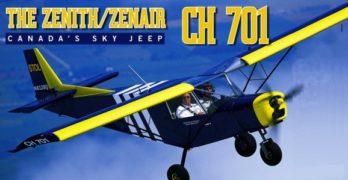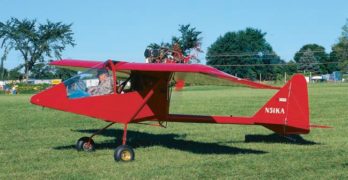CENTRAL FLORIDA–
At the start of the big Sun ‘n Fun airshow, I had the pleasure to fly John
Dunham’s American Tug built for him by ultralight producer, M Squared
of Alabama. This design resembles the popular Quicksilver ultralights that evolved
from the original hang glider of the late 1970s. Beefed up for the hard duty that
is aero towing, the M Squared entry is a robust ultralight that should be capable
of steady operation as a tractor of the air. American Tug is a single-place aircraft
employing a 32-foot span, high-lift, slow-flying, single-surface, strut-braced wing.
While Dragonfly has been the lone fixed-wing tug in the USA, flight parks and clubs
now have another choice. And, importantly, the American Tug — as opposed to the
“Australian tug,” John says — costs substantially less. A basic Rotax 582-powered
tug should sell for about $20,000 says John. The American
Tug I flew, with a custom-configured 680 cc Rotax engine rated at 100 hp, demonstrated
an acceptable climb rate while towing plus excellent low speed controllability.
Search Results for : Quicksilver
Not finding exactly what you expected? Try our advanced search option.
Select a manufacturer to go straight to all our content about that manufacturer.
Select an aircraft model to go straight to all our content about that model.
The Primary Category
FAA established the Primary Category in 1992 at the request of EAA and other general aviation groups, to allow for the manufacture of ready-to-fly airplanes or kit aircraft that could be built under a manufacturer-supervised program. Primary Category aircraft are limited to a gross weight of 3,000 pounds, or less, and must be powered by a certificated engine and propeller. They can be used for training or recreational flying.
A sub-category of the Primary Category is called Sportplanes; a sportplane is defined as any single or two-place aircraft with a maximum takeoff weight of 1,200 pounds, or less, and a maximum stall speed of 45 knots. They are limited to day VFR, normal category operation. Currently, two aircraft-the Quicksilver GT 500 and the RANS S-7C-have been certified under this category.
A minimum of a Recreational pilot’s certificate (or student endorsement) is required to operate such aircraft.
Published in EAA Sport Pilot & Light Sport Aircraft Magazine
Canada’s Sky Jeep
Pilots will go to great lengths to fly airplanes they like. I went to the Czech Republic to fly the CH 701. That’ s a long way, and I did like the airplane. The experience tells a story of light-sport aircraft development that may become increasingly common.
Like most light plane pilots, I’ve long been familiar with the designs of Swiss-born engineer Chris Heintz. His many aircraft models have put some 2,000 builders in the air. The low-wing, Piper Cherokee-like CH 601 is far and away the most popular air plane he’s designed, with it representing more than 60 percent of all Zenith models sold. Yet, perhaps the most distinctive-looking design he’s offered is the short takeoff and landing (STOL) capable CH 701, the subject of our discussion this month. Now the world grows smaller with Heintz’s Canadian designs being manufactured in the Czech Republic and freighted to the United States for fun in the sky.
Simple Done Right
AirBorne’s Outback trike has all the essentials
Light-sport aircraft (LSA) are on the minds of many would-be sport pilots, especially now that the proposed rule has advanced from the Depart-ment of Transportation (DOT) to the Office of Management and Budget (OMB) for its last review. But the big-picture view of these airplanes is complex. Yes, we’ll have sleek im-ported machines like the CT2K, G3 Mirage, SkyBoy, or SportStar, but we’ll also have much more. We will also still have popular American-made machines like Zenith’s CH 601, SkyStar’s Kitfox, Quicksilver’s MX or GT series, RANS’ Coyotes, Quad City Ultralight’s Challenger, and more. And we’ll have trikes, powered para-chutes, gliders, airships, gyros, and who-knows-what-else. The new LSA category actually represents a virtual zoo of different aerial animals. The fiberglass or metal versions that may enter our market from Europe are but the upper end of the spectrum, in both speed and price.
Trikes, in particular, may be one of the earlier qualifying entries.
A Civilized Kolb Sport 600
My first thought when I exited the Kolb Sport 600 after flying it was, “This is a very civilized aircraft.” Is that typical of what we can expect when light-sport aircraft (LSA) become the law of the land? I sure hope so|though I also hope Part 103 ultralights and kit aircraft continue to enjoy a solid share of the overall market.
With its sleek composite exterior, all-metal wing, custom interior, international (Canadian) design heritage, and cross-country performance, the Sport 600 from New Kolb Aircraft sets a pace others may hope to follow.
My test airplane for this month’s article was the personal property of New Kolb Aircraft owner Bruce Chesnut. That explains the gorgeous interior finished by a professional in Alabama: Leather-covered seats and fittings, tasteful embroidery, and beautifully formed and finished plastic covers graced the aircraft. Bruce’s Sport 600 also had attitude (IFR, or instrument flight rules) instruments, which is rare in the ultralights or kit-built aircraft I typically review.
Light Sport Aircraft Specifications
How do we evaluate light-sport aircraft?
The FAA’s proposed SportPlanes™ /light-sport aircraft (LSA) rule is being discussed in hangars across America. But it is also being discussed at airports all over Europe—more than you may think. The global reach of this initiative is visible by the large number of European suppliers aiming their sights on the huge U.S. market. Many believe they have an aircraft that fits the standard.
In the previous issue of KITPLANES®, you read Brian E. Clark’s summary of how European aircraft manufacturers are responding to LSA. In this issue, you can look at Barnaby Wainfan’s analysis of the aerodynamics of aircraft that meet the standard.
In concert, this column attempts to add information about LSA candidate aircraft that are flying now. I’ve had the pleasure to fly many of the aircraft that may one day call themselves LSAs. In that flying, I’ve learned some lessons about what you might expect and how to evaluate what interests you.
How-to-Buy a Lightplane — Part 3 of 3
In the previous two installments, we’ve discussed you, the pilot, and the many types of aircraft choices you have. As we wrap up this series, we’ll put it all together and try to help you narrow your choices to a few models.
Notice the word “try.” It is important that you understand that it is not possible to direct you to the one-and-only best choice of aircraft. Novice buyers often seek assistance but even experienced pilots can become swayed and end up purchasing the wrong aircraft for their needs and desires. Because aircraft purchases are commonly emotional decisions, it is helpful to gain a “second opinion” to help make a more rational choice.
Many years ago, at the beginning of my career writing articles in light aviation, I made a similar attempt to help hang glider pilots choose the right glider. I compared nine contemporary models to an idealized “perfect” glider and through a series of questions much like those below, tried to steer pilots to the one right glider for them.
How-to-Buy a Lightplane — Part 2 of 3
FACING THE BUYING DECISION, PART II
Last time we discussed the pilot (you!); this time we discuss the many types of aircraft choices you have. In the last installment, we’ll put these together and help you narrow your choices to a few models.
What Kind of Pilot Are You?
Let’s just say you actually know yourself. While this sounds like a comment that deserves a “Duh!” response, don’t be too quick to judge. If every pilot or buyer of aircraft knew what they needed or wanted, my job would be easier. But it isn’t so. Most pilots know something about what they want, but many don’t have enough information to make the best decision.
Some readers are “experts.” A good many ultralight or light plane enthusiasts have been around long enough and owned enough variety of ultralights to know what they like.
These veteran sport aviators represent a lot of combined experience.
Product Lines – February 2003
St. Paul, Minn. — Please bear with me as I use all of this month’s column on something that has little to do with products, the usual focus of this column. I’ve been doing this bit of writing for Hang Gliding magazine for a long time (“PL” finishes 24 years with this issue), but one man has been even more long lived. lll After 25 years on the job, Hang Gliding editor Gil Dodgen handed off all his duties to Dan Nelson, a new paraglider pilot with an editorial background. Gil started with USHGA’s magazine with the January, 1978 issue. For those with weak memories or those too new to hang gliding to know the past, an extremely brief history lesson is in order. s In 1978, the Big Three of hang glider building in the USA were Seagull, Electra Flyer, and Wills Wing. We had other prominent Yankee brands like Sky Sports, Bennett Delta Wing, Eipper-Formance, Ultralite Products, Manta, Sunbird, Highster, and CGS Aircraft.
Product Lines – November 03
St. Paul, Minn. — Again with the motor news…? These little contraptions are making quite a… how nicely can I put it? — “joyful noise.” The vote is now history. As I write this in late September, the count has not been made but trends pointed toward acceptance. • Time to take a breather and then move on. Let’s realize that we only have a few hundred of these motor guys. Some flying sites will have to work out compatibility issues, but for the most part powered harnesses, powered paragliders, and nanotrikes allow flight from places closer to home. When they do fly in the company of unpowered hang gliders or paragliders, they are among the quietest of ultralights as their engines have commonly been developed in noise-sensitive Europe. • This column will continue to track the field. But these tiny rigs are simply engines on hang gliders or paragliders and the wings still fly the same (they may even have similar wing loading through the use of larger wings).
- « Previous Page
- 1
- …
- 16
- 17
- 18
- 19
- 20
- 21
- Next Page »







